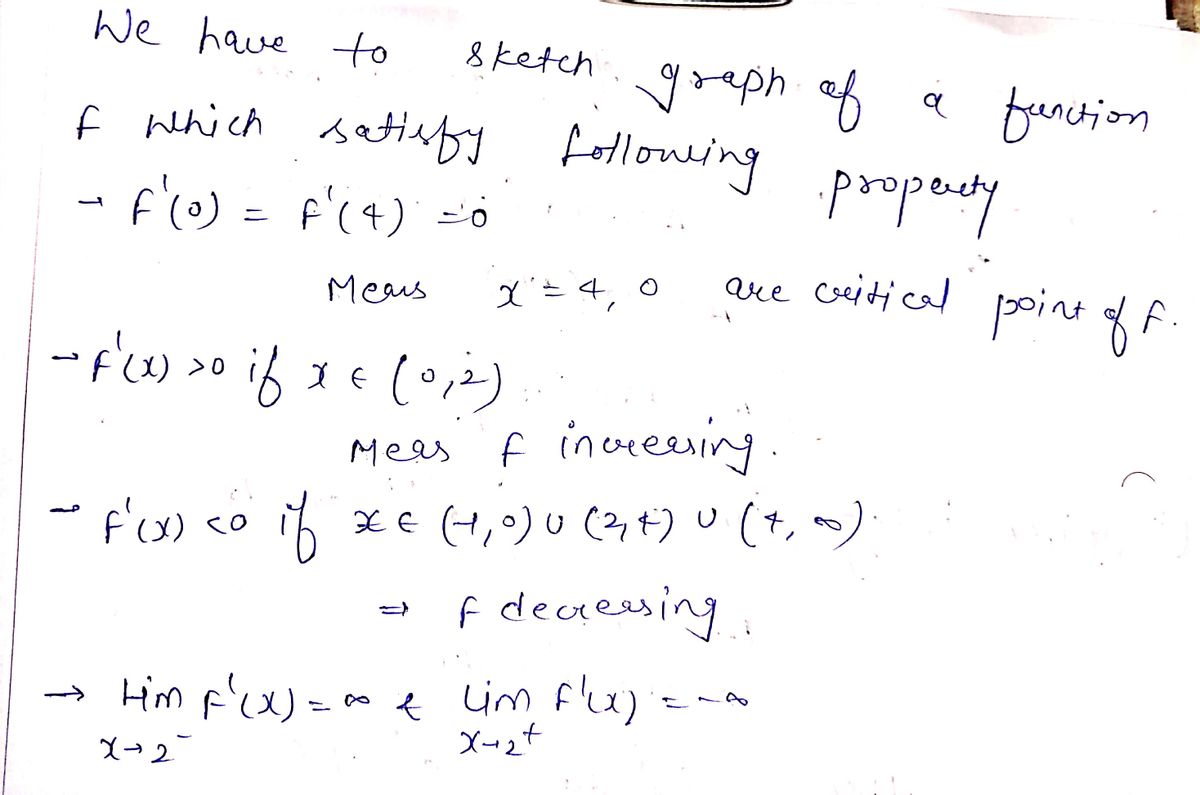Sketch the graph of a function that satisfies all of the given conditions. f'(0) = f'(4) = 0, f'(x) = 1 if x < -1, f'(x) > 0 if 0 4, lim f'(x) = ∞, lim f'(x) = -∞, x→2+ f"(x) > 0 if – 1< x < 2 or 2 < x < 4, f"(x) < 0 if > 4
Sketch the graph of a function that satisfies all of the given conditions. f'(0) = f'(4) = 0, f'(x) = 1 if x < -1, f'(x) > 0 if 0 4, lim f'(x) = ∞, lim f'(x) = -∞, x→2+ f"(x) > 0 if – 1< x < 2 or 2 < x < 4, f"(x) < 0 if > 4
Calculus: Early Transcendentals
8th Edition
ISBN:9781285741550
Author:James Stewart
Publisher:James Stewart
Chapter1: Functions And Models
Section: Chapter Questions
Problem 1RCC: (a) What is a function? What are its domain and range? (b) What is the graph of a function? (c) How...
Related questions
Question
Please solve and show all work, thank you!

Transcribed Image Text:**Sketch the Graph of a Function with Given Conditions**
Given Conditions:
1. \( f'(0) = f'(4) = 0 \)
2. \( f'(x) = 1 \) if \( x < -1 \)
3. \( f'(x) > 0 \) if \( 0 < x < 2 \)
4. \( f'(x) < 0 \) if \( -1 < x < 0 \) or \( 2 < x < 4 \) or \( x > 4 \)
5. \( \lim_{{x \to 2^-}} f'(x) = \infty \)
6. \( \lim_{{x \to 2^+}} f'(x) = -\infty \)
7. \( f''(x) > 0 \) if \( -1 < x < 2 \) or \( 2 < x < 4 \)
8. \( f''(x) < 0 \) if \( x > 4 \)
**Explanation:**
- \( f'(x) \) describes the slope or rate of change of the function. When \( f'(x) = 0 \), the function has a horizontal tangent, usually at local maxima, minima, or points of inflection.
- \( f'(x) > 0 \) indicates the function is increasing.
- \( f'(x) < 0 \) indicates the function is decreasing.
- \( \lim_{{x \to 2^-}} f'(x) = \infty \) shows the slope approaches positive infinity as \( x \) approaches 2 from the left.
- \( \lim_{{x \to 2^+}} f'(x) = -\infty \) shows the slope approaches negative infinity as \( x \) approaches 2 from the right, suggesting a vertical asymptote.
- \( f''(x) \) is the second derivative, indicating concavity. \( f''(x) > 0 \) implies the function is concave up, and \( f''(x) < 0 \) means it is concave down.
Expert Solution
Step 1

Step by step
Solved in 2 steps with 2 images

Recommended textbooks for you

Calculus: Early Transcendentals
Calculus
ISBN:
9781285741550
Author:
James Stewart
Publisher:
Cengage Learning

Thomas' Calculus (14th Edition)
Calculus
ISBN:
9780134438986
Author:
Joel R. Hass, Christopher E. Heil, Maurice D. Weir
Publisher:
PEARSON

Calculus: Early Transcendentals (3rd Edition)
Calculus
ISBN:
9780134763644
Author:
William L. Briggs, Lyle Cochran, Bernard Gillett, Eric Schulz
Publisher:
PEARSON

Calculus: Early Transcendentals
Calculus
ISBN:
9781285741550
Author:
James Stewart
Publisher:
Cengage Learning

Thomas' Calculus (14th Edition)
Calculus
ISBN:
9780134438986
Author:
Joel R. Hass, Christopher E. Heil, Maurice D. Weir
Publisher:
PEARSON

Calculus: Early Transcendentals (3rd Edition)
Calculus
ISBN:
9780134763644
Author:
William L. Briggs, Lyle Cochran, Bernard Gillett, Eric Schulz
Publisher:
PEARSON

Calculus: Early Transcendentals
Calculus
ISBN:
9781319050740
Author:
Jon Rogawski, Colin Adams, Robert Franzosa
Publisher:
W. H. Freeman


Calculus: Early Transcendental Functions
Calculus
ISBN:
9781337552516
Author:
Ron Larson, Bruce H. Edwards
Publisher:
Cengage Learning